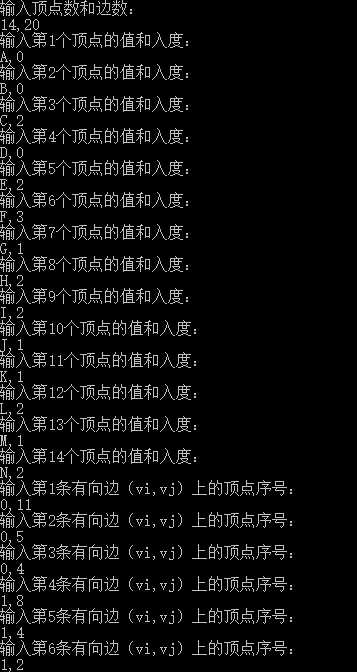C語言實現有向無環圖的拓撲排序演算法
對AOV網進行拓撲排序的基本思路是:從AOV網中選擇一個入度為0的頂點輸出,然後刪除此頂點,並刪除以此頂點為尾的弧,繼續重複此步驟,直到輸出全部頂點或者在AOV網中不存在入度為0的頂點為止。
這裡圖使用的資料結構是鄰接表,並且在頂點表加入頂點入度一項。
以下程式在DEV C++中編譯執行通過。
#include <stdio.h>
#include <stdlib.h>
#define MAXVEX 20
typedef struct EdgeNode
{
int adjvex;//鄰接點域,儲存該頂點對應的下標
struct EdgeNode *next;//鏈域,指向下一個鄰接點
}EdgeNode;
typedef struct VertexNode
{
int in;//頂點入度
char data;//頂點域,儲存頂點資訊
EdgeNode *firstedge;//邊表頭指標
}VertexNode,AdjList[MAXVEX];
typedef struct
{
AdjList adjList;
int numVertexes,numEdges;
}GraphAdjList;
void CreateALGraph(GraphAdjList *G)
{
int i,j,k;
EdgeNode *e;
printf("輸入頂點數和邊數:\n");
scanf("%d,%d",&G->numVertexes,&G->numEdges);
getchar();
for(i=0;i<G->numVertexes;i++)
{
printf("輸入第%d個頂點的值和入度:\n",i+1);
scanf("%c,%d",&G->adjList[i].data,&G->adjList[i].in);
G->adjList[i].firstedge=NULL;
getchar();
}
for(k=0;k<G->numEdges;k++)
{
printf("輸入第%d條有向邊(vi,vj)上的頂點序號:\n",k+1);
scanf("%d,%d",&i,&j);
e=(EdgeNode*)malloc(sizeof(EdgeNode));
e->adjvex=j;
e->next=G->adjList[i].firstedge;
G->adjList[i].firstedge=e;
}
}
int TopologicalSort(GraphAdjList *G)
{
EdgeNode *e;
int i,k,gettop;
int top=0;//用於棧指標下標
int count=0;//用於統計輸出頂點的個數
int *Stack;//建棧儲存入度為0的指標
Stack=(int*)malloc(G->numVertexes*sizeof(int));
for(i=0;i<G->numVertexes;i++)
{
if(G->adjList[i].in==0)
Stack[++top]=i;//將入度為0的頂點的序號入棧
}
while(top!=0)
{
gettop=Stack[top--];
printf("%c->",G->adjList[gettop].data);
count++;
for(e=G->adjList[gettop].firstedge;e;e=e->next)
{
//對此頂點的弧表進行遍歷
k=e->adjvex;//鄰接點的序號
if(!(--G->adjList[k].in))
Stack[++top]=k;
}
}
if(count<G->numVertexes)
return -1;
else
return 0;
}
void main()
{
GraphAdjList G;
int flag;
CreateALGraph(&G);
flag=TopologicalSort(&G);
if(flag==-1)
printf("該有向圖存在環,構造拓撲序列失敗!\n");
else if(flag==0)
printf("構造拓撲序列成功!\n");
}執行結果如圖所示。
求出的結果不是唯一的拓撲排序方案。
整個演算法的時間複雜度為O(n+e),n是頂點數,e是邊數。
相關文章
- 拓撲排序 (BFS )DAG (有向無環圖)排序
- 資料結構與演算法——有向無環圖的拓撲排序C++實現資料結構演算法排序C++
- 有向圖的拓撲排序——DFS排序
- C++輸出有向無環圖的所有拓撲序列C++
- POJ1094[有向環 拓撲排序]排序
- 圖的拓撲排序詳解與實現排序
- 圖解拓撲排序+程式碼實現圖解排序
- 演算法-圖論-拓撲排序演算法圖論排序
- DFS實現拓撲排序排序
- 圖論——拓撲排序圖論排序
- 排序演算法-C語言實現排序演算法C語言
- Reward (圖論+拓撲排序)圖論排序
- 快速排序演算法(C語言實現)排序演算法C語言
- 拓撲排序排序
- 經典排序演算法的 C語言 | Java 實現排序演算法C語言Java
- vue 實現動態拓撲圖Vue
- C語言實現九大排序演算法C語言排序演算法
- 拓撲排序,YYDS排序
- 拓撲排序模板排序
- Rama透過拓撲通用語言實現ACID事務
- 【圖論】拓撲排序+優先佇列圖論排序佇列
- 拓撲排序小結排序
- 筆記:拓撲排序筆記排序
- 演算法資料結構 | 圖論基礎演算法——拓撲排序演算法資料結構圖論排序
- 用C實現撲克牌排序排序
- 圖(3)--拓撲排序與關鍵路徑排序
- 如何在 Java 中實現無向環和有向環的檢測Java
- 求有向圖的強連通分量(c語言版)C語言
- 拓撲排序 - Topological Sort排序
- 拓撲排序核心程式碼排序
- HDU 4857 逃生(拓撲排序)排序
- 【筆記/模板】拓撲排序筆記排序
- AOV網與拓撲排序排序
- 用C#實現撲克牌排序C#排序
- 有向圖的基本演算法-Java實現演算法Java
- C語言實現A*演算法薦C語言演算法
- 拓撲排序就這麼回事排序
- HDU4857逃生(拓撲排序)排序

